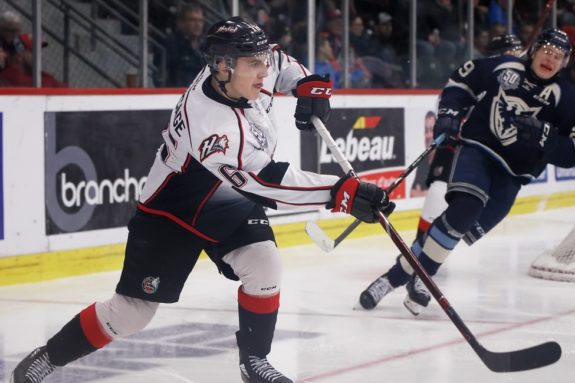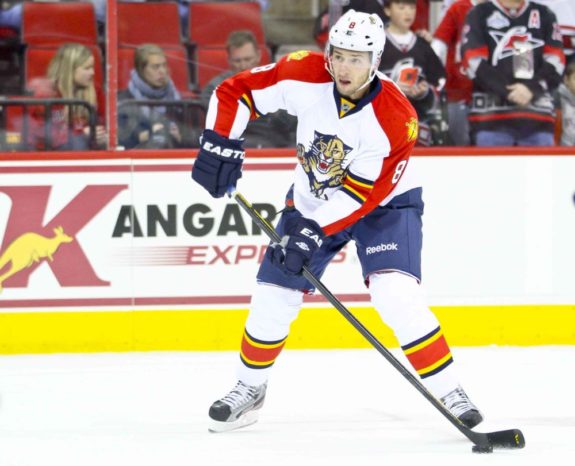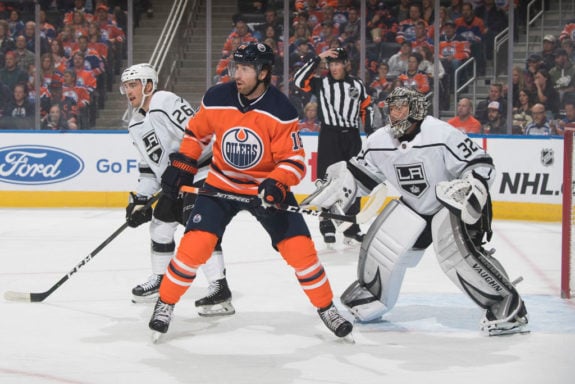Within the next two seasons, there are expectations that the Colorado Avalanche’s top two forward prospects, left-winger Shane Bowers and center Alex Newhook, will earn full-time roles with the club. At least initially, they’ll fill holes left empty by the departure of some of the Avs’ bottom-six free agents.
Long-term, though, Alex Beaucage is the Avs’ best long-term forward prospect who most likely won’t challenge for a roster spot until the 2023-24 season. The high scoring Rouyn-Noranda Husky is another example of how general manager Joe Sakic is leveraging the draft to perennially challenge for the Cup and develop a robust financial situation.
New Team Leader Needs Improvement
Beaucage ranked 15th in U-20 QMJHL scoring this season with a 40-goal, 70-point campaign across 63 games (1.11 PPG). Granted, this represented a decrease in scoring from 2018-19 that saw him score 78 points in 69 games (1.16 PPG), but the Huskies lost several strong players after last season.

The 2019-20 season threw Beaucage into a leadership role with the kind of off-ice responsibilities that typically come with being a mentor to younger teammates. In a post-draft interview last summer with NHL.com, Beaucage anticipated his new role with the Huskies:
It should be a big summer. Going back to Rouyn-Noranda in the fall, I will have a bigger role. Our team will be younger, so it will be my role to be a leader on that team and help the younger guys on the team.
What I noticed watching him skate is that while his form and first-step are below average, he has a very strong lower body. His size really sticks out and he looks like a man among boys. That helps to compensate for his wonky skating style. He takes a few steps too many when moving laterally or to pick up speed, but because of his strength, he’s able to stay well-balanced. He’s slow to get going because he’s not an efficient skater yet but he’s able to stay very balanced despite his poor technique.
Related: What Joe Sakic Means to the Avalanche
Measured at 6-foot-1 and 192 pounds by NHL Central Scouting prior to last summer’s draft, Beaucage already had an NHL frame at 17 years old. Also, he has elite accuracy with all of his shots. He can pick his spots from up close at any angle and his puck control down is so good that goalies have a difficult time reading him.
It’ll take a few years to develop his skating more, and keeping him in the QMJHL for longer might be good for him. The ECHL could be an option for Beaucage in 2021-22 as well if the Avs front office wants him to gain professional experience. It’s unlikely that he’ll be ready for the AHL after only one more season with Rouyn-Noranda.
Where Will His Pro Career Begin?
Even though the ECHL is an inferior league to the AHL, it’s still considered a feeder league to the NHL. Many NHL players have started their professional careers down there. The 2019-20 season marked the 23rd consecutive season in which an ECHL club has been formally recognized as affiliates for at least 20 NHL teams. Additionally, there were 57 ECHL alumni who were coaches or players in the NHL at the beginning of this season.
Assuming he’s continuously learning and improving during the next five seasons, Beaucage could start the 2022-23 campaign in the AHL. At that time he’ll only be 21, still young enough to take a couple of seasons to adapt to the fastest and toughest minor league in North America. Several current and former Avs didn’t make their NHL debuts until their mid-to-late twenties, like Pierre-Eduoard Bellemare (29 years old), Carl Soderberg (27), Shjon Podein (24), Johnny Boychuk (24), and Jeff Finger (27).
The fact that he vocalizes how his skating needs improvement right after he got drafted shows a lot of maturity on his part. He very easily could have used his high draft slot to dismiss criticism of his skating. Instead, he confronts reality head-on and genuinely seems serious about improving his flaws. It’s this self-accountability that paint Beaucage as a leader.
Budding Power Forward Comparisons
Since Beaucage’s NHL arrival date is so far into the future, it’s not really feasible to predict where he’ll fit on the Avs. It’s better to compare him to current or former NHLers to approximate his upside. In its 2019 NHL Draft guide, Riding Pine Hockey ranked Beaucage as its 69th-ranked prospect, comparing him to Wojtek Wolski. Before his career was beset by numerous injuries, Wolski played 302 games for the Avs over five seasons and scored 193 points. That 0.63 points per game clip equals around 52 points per season.
According to Burgundy Review, Beaucage had one of the higher even-strength scoring percentages in the 2019 Draft. Wolski also didn’t score many power-play points in his career, totaling just 47 over parts of eight seasons in the NHL. Wolski was known as a solid two-way winger in Colorado, with his defensive play contributing to 1.2 to 2.4 team standings points. Beaucage showed defensive promise during the 2019 Avs’ development camp, and he certainly has the size along the boards that the Avs covet.
The main difference between Wolski and Beaucage is that Wolski was a tremendously fluid skater. He was the Avs’ best penalty-shot taker in 2008-09, having scored the second-most penalty shots in one season (10 goals on 12 shots). Wolski was also a couple of inches and 20 pounds heavier, so it’s not the best comparison for the young Avs prospect. Scoring-wise, Wolski’s early career seems like a fair expectation for Beaucage, provided he betters his fundamentals.

A better comparison for Beaucage is James Neal. Neal substantially filled out his frame during his professional career, but NHL Central Scouting listed him at 6-foot-2 and 185 pounds prior to the 2005 Draft. At the time, his skating and defensive product needed work but he was praised for his leadership, shooting ability and frequency, and work along the boards. Beaucage doesn’t take bad penalties like Neal and his defensive game is probably ahead of where Neal’s was at the same point in his career, but there are a lot of similarities here.
Neal played just over three seasons in the OHL where he scored about a point per game. During his second and third full seasons there, he scored 123 points and registered 203 PIMs. He got the penalties under control somewhat in the AHL before making his NHL debut during the 2008-09 season. With the exception of 2011-12 in which he played on Sidney Crosby’s line, Neal’s mostly been a 40 to 60-point per season player in the NHL.
In his 12-season NHL career, he’s taken 2,432 shots, which is more than Ryan Getzlaf, Claude Giroux, and Mikko Koivu, and Neal has an overall shooting percentage of 11.9 percent. Like Neal, Beaucage loves to shoot often. In 2019-20, Beaucage was fourth in the QMJHL in total shots and 12th in dangerous shots. In the previous season, he was 11th in the “Q” in total shots and 26th in the ones up close.

It’s likely that Beaucage spends 2020-21 playing junior hockey and then at least two seasons in the minors before competing for an Avs roster spot. He’s a toolsy wing prospect with NHL size and shooting prowess who needs to refine his skating and learn the Avs’ forechecking style. Neal also adapted his game to a changing NHL in which power forwards weren’t expected to rack up 200 PIMs per season.
Neal found his niche as a leader in the locker room and a dangerous shooter on the ice who used his size as a benefit, not a liability. Beaucage has a similar opportunity to further develop his character and on-ice product before he reaches the NHL. The Avalanche should be thrilled if they develop a third-round pick into the next James Neal.